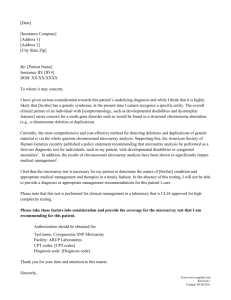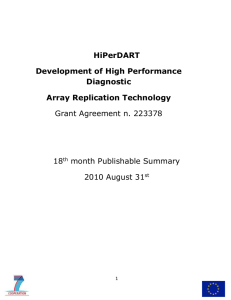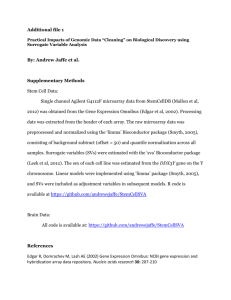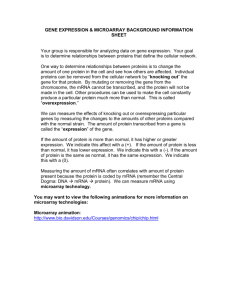Protein Detection and measuremeant
advertisement
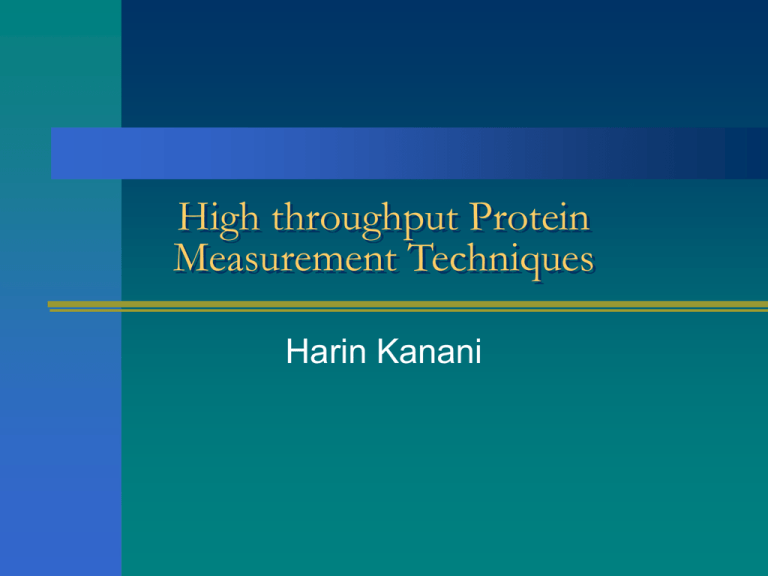
High throughput Protein Measurement Techniques Harin Kanani Proteins: –Biological Macromolecules –Functional Protein - Enzymes –Structural Protein –Antibody for Cell defense –Signalling Proteins Motivation for Protein measurement: –Basic biological research –Biomarkers : Molecular Classification & Diagnosis of disease –Drug Discovery –For profiling response of biological systems to toxins and pharmaceuticals Motivation High throughput Measurement: ::Genomic Revolution:: – Rapid (?) measurement of a large number of samples – non-hypothesis approach of research – Final Aim is - “Simultaneous, Complete, quantitative analysis of all Gene Expressions/ Proteins” High throughput Measurement: Signaling reactions DNA mRNA Proteins Proteomics Genomics •Genechip •DNA Microarray •Proteinchip •Protein Array Metabolic reactions Metabolomics •GC-LC / MS •NMR High throughput Measurement: Proteins Proteomics Genomics •Genechip •DNA Microarray •Proteinchip •Protein Array Metabolomics •GC-LC / MS •NMR ProteinchipTM Protein Capture Chips for Mass Spectrometry Using SELDI – Surface Enhanced Laser Disorption Ionization Or MALDI – Matrix Assisted Laser Disorption Ionization Protein Capture-chips: ProteinchipTM : Procedure Application of Crude Sample: Step:1 ProteinchipTM : Procedure Wash chip to remove non-specifically binded protein/background: Step: 2 Protein Capture-chips – MS: Procedure Add Energy Absorbing Molecules (EAS) or “Matrix”: Step: 3 This step loosens the protein binding Protein Capture-chips – MS: Procedure Use Laser for desorption and ionization of protein : Step: 4 TOF (Time of Flight Mass Spectrometer): Measure Molecular weight – Get Spectrum Protein Capture-chips – MS: Results Generating m/z vs Intensity Plots Step: 5 Protein Capture-chips – MS: Results ProteinchipTM CIPHERGEN Proteinchip Biology System Protein Microarray High-throughput Quantification (Profiling) using specific antibody – antigen Interaction & relative intensity of floroscent signal Protein Microarray Technology: Slide Chemistry Slide Preperation Protein Imobilization Quenching Additional sites bovine serum albumin (BSA) Protein Microarray Technology: Protein Detection Protein Microarray Technology: Intensity vs. Protein Concentration Protein Microarray Expression Profiling Control Sample Protein Microarray Technology: Microarrayer Scanning Image Analysis Software Measure intensity with Cy-3 and Cy-5 Filter Protein Microarray Technology: Data Normalization Experimental Conclusion/ Discoveries Relative Protein Abundance In a sample Statistical Techniques To compare Relative Abundance in different samples Microarrayer : AFFIMATRICS GMS-417 Arrayer Proteine Microarray: Proteine Microarray: Commercial Protein Measurement Technique: Commercial Protein Measurement Technique: Many Techniques being explored… but very few Commercial products in the market Inspite of high demand Because…… Protein Measurement: Bottlenecks.. – Capture agents: shortage of sufficiently specific antibodies or their ligands – Problem due to different forms of the post translational protein – Protein deactivation on micro array surfaces Protein Measurement: Bottlenecks.. – High throughput purification techniques which do not affect functional form of proteins – lack of uniform labelling due to different protein properties ..(upto 10 fold difference) – Varying protein concentration (~10^14) ..different concentration requires different conditions High throughput Protein Measurement Beginning of a long journey ahead…. Thank You References: Mitchell P, “ A perspective on protein microarray”, Nature Biotechnology, 20, 225 Haab B., et. al., “ Protein microarray for highly parallel detection and quantitation of specific proteins and antibodies in complex solutions”, Genome Biology 2001, 2(2):research/004.1 Proteinchip Publications, literature and posters on: – www.ciphergen.com MacBeath et al., “Printing Proteins as Microarrays for HighThroughput Function Determination”, SCIENCE, 289, 1760 Zhu et. al., “ Global analysis of protein activities using proteome chips”, SCIENCE, 293, 2101



